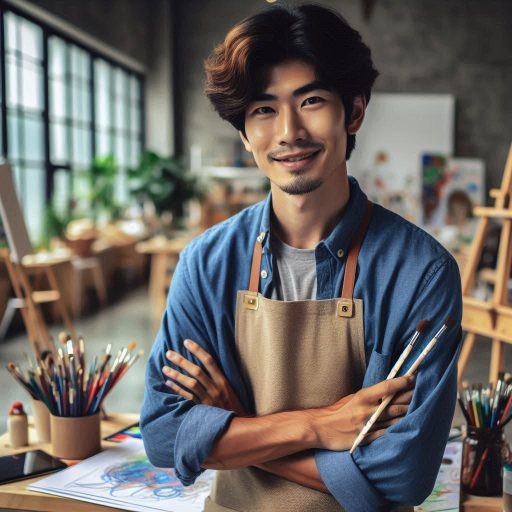Introduction
Motivation is crucial in art and design classes.
It fuels students’ passion and drives their creative endeavors.
Without motivation, students might lack enthusiasm and engagement in their projects.
Understanding this importance can lead to better teaching strategies and improved student outcomes.
In art and design, motivation sparks creativity.
When students are motivated, they are more likely to explore new techniques and experiment with various styles.
This exploration fosters innovation and enhances their ability to think outside the box.
A motivated student views challenges as opportunities, not obstacles.
Moreover, motivation directly impacts skills development.
Engaged students dedicate more time to practice and refine their skills.
They seek out feedback and apply it to improve their work.
This commitment accelerates their learning process and enhances their technical abilities.
When educators create an environment that fosters motivation, students thrive.
They become more invested in their work and more willing to push their creative boundaries.
This active engagement leads to a richer learning experience and more impressive results.
In summary, motivation in art and design classes is vital.
It encourages creativity, drives exploration, and accelerates skill development.
By focusing on strategies to boost motivation, educators can significantly enhance students’ artistic growth and achievements.
Create a supportive and positive learning environment
Building a supportive and positive learning environment in art and design classes is essential for motivating students to excel in their creativity and skills.
By following these key strategies, educators can create an atmosphere that encourages students to thrive and develop their passion for art and design.
Transform Your Career Today
Unlock a personalized career strategy that drives real results. Get tailored advice and a roadmap designed just for you.
Start NowEncourage open communication between students and teachers
One of the most effective ways to motivate students in art and design classes is to foster open communication between students and teachers.
By creating a safe space where students feel comfortable sharing their ideas, thoughts, and concerns, educators can build trust and rapport with their students.
Encouraging students to communicate openly with their teachers allows for a more personalized learning experience.
Teachers can better understand their students’ strengths, weaknesses, and areas for growth, which enables them to provide targeted support and guidance.
Provide constructive feedback and praise for effort
Feedback plays a crucial role in student motivation and learning.
In art and design classes, providing constructive feedback that is specific, actionable, and encouraging can help students improve their skills and build confidence in their artistic abilities.
It is important for teachers to recognize and acknowledge the effort that students put into their work.
By praising students for their hard work and perseverance, educators can boost students’ self-esteem and motivation to continue pushing themselves to achieve their artistic goals.
Foster a sense of community and collaboration among students
Collaboration is a key component of success in art and design classes.
By fostering a sense of community and teamwork among students, educators can create a supportive and inclusive environment where students feel motivated to learn from one another and work together towards common goals.
Encouraging collaboration also helps students develop important social and communication skills that are essential for success in the creative industries.
By working together on projects and sharing ideas, students can gain valuable insights and perspectives that can enhance their creative processes and outcomes.
In short, creating a supportive and positive learning environment in art and design classes is crucial for motivating students to achieve their full potential.
By following these strategies and fostering open communication, providing constructive feedback, and promoting collaboration, educators can inspire students to thrive and excel in their artistic endeavors.
Read: How to Handle Creative Blocks in Design
Set clear goals and expectations
Clearly outline learning objectives for each project or assignment
Setting clear goals and expectations is crucial for motivating students in art and design classes.
Start by clearly outlining learning objectives for each project or assignment.
When students understand what they need to achieve, they can focus their efforts more effectively.
Detailed objectives provide a roadmap for success and help students grasp the relevance of their tasks.
Break down goals into manageable steps to track progress
Next, break down goals into manageable steps to track progress.
Large projects can seem overwhelming, but smaller, achievable milestones make them more approachable.
By segmenting goals, students can see their progress, which boosts their motivation.
Each completed step serves as a mini-success, fostering a sense of accomplishment and encouraging further effort.
Individual goals with students to personalize motivation strategies
Additionally, discuss individual goals with students to personalize motivation strategies.
Every student is unique, with different strengths and areas for improvement.
Personalized discussions help identify what drives each student and how they best engage with their work.
Tailoring goals to align with their interests and aspirations makes the learning experience more relevant and stimulating.
Regularly revisiting and adjusting these goals based on student feedback ensures they remain relevant and challenging.
This ongoing dialogue helps keep students engaged and motivated, as they see their input valued and incorporated into their learning journey.
In essence, setting clear goals and expectations, breaking them down into manageable steps, and personalizing motivation strategies are essential for encouraging students in art and design classes.
These practices help students stay focused, track their progress, and remain engaged, ultimately enhancing their learning experience and success.
Read: Collaborating with Other Art Educators
Incorporate Variety and Creativity into Lessons
To keep students motivated in art and design classes, incorporating variety and creativity into lessons is essential.
This approach not only maintains their interest but also enhances their learning experience.
Use Diverse Teaching Methods
Employing diverse teaching methods can significantly impact student engagement.
Visual demonstrations, such as showing step-by-step processes or live sketches, make concepts clearer.
Hands-on activities, like creating mini-projects or interactive exercises, help students practice what they’ve learned.
Integrating technology, such as digital tools and online resources, can further enrich the learning environment.
By mixing these methods, you cater to different learning styles and keep lessons dynamic and engaging.
Integrate Real-World Examples and Case Studies
Incorporating real-world examples and case studies into lessons can inspire students and make learning more relevant.
Showcasing successful artists or designers and their work provides students with practical insights into their future careers.
Discussing current trends and industry practices helps students understand the real-world application of their skills.
Case studies of famous projects or innovative designs can spark creativity and motivate students to think outside the box.
Allow Students to Explore Different Mediums and Techniques
Encouraging students to explore various mediums and techniques keeps them engaged and fosters creativity.
Let them experiment with different materials, such as acrylics, watercolors, or digital tools, to discover their preferences.
Offering opportunities to try new techniques, like mixed media or digital art, helps broaden their skills.
By allowing experimentation, students can find their unique style and develop a deeper connection to their work.
Incorporating these strategies ensures that art and design classes remain stimulating and effective.
By diversifying teaching methods, integrating real-world examples, and encouraging exploration, you create a dynamic learning environment that motivates students and enhances their creative growth.
Read: Marketing Yourself as a Costume Designer

Offer opportunities for self-expression
Provide freedom for students to explore their own artistic styles and interests
Encouraging self-expression is vital in art and design education.
Students thrive when given the freedom to explore their own artistic styles and interests.
Allowing them to choose their projects empowers them to engage more deeply with their work.
When students can pursue topics that resonate with them, their creativity flourishes, leading to more meaningful and personalized artwork.
Encourage students to take risks and think outside the box
Encouraging students to take risks and think outside the box fosters innovation.
Art and design are about experimentation and pushing boundaries.
By creating a classroom environment where risks are welcomed, students feel more confident to try new techniques and ideas.
This approach not only enhances their skills but also helps them develop a unique artistic voice.
Showcase student work in exhibitions or competitions to celebrate creativity
Showcasing student work in exhibitions or competitions is a powerful way to celebrate creativity.
Publicly displaying their creations acknowledges their hard work and achievements.
It boosts their confidence and motivates them to continue exploring their artistic potential.
Participating in competitions or exhibitions also provides valuable feedback and encourages students to strive for excellence.
Incorporating these strategies into art and design classes promotes a supportive and inspiring environment.
By offering freedom, encouraging risk-taking, and showcasing achievements, educators can help students develop their artistic talents and gain a deeper appreciation for their creative capabilities.
These practices not only enhance their technical skills but also nurture their confidence and passion for art and design.
Read: Finding Freelance Opportunities as Art Instructors
See Related Content: Building a Strong Fashion Design Portfolio
Gain More Insights: Top Design Schools for Aspiring Product Designers
Provide mentorship and guidance
Mentorship and guidance play a crucial role in motivating students in art and design classes.
By providing personalized support and feedback, students feel valued and encouraged to excel in their creative pursuits.
Pair students with mentors or industry professionals for personalized support
Pairing students with mentors who are experienced in the field can have a significant impact on their growth and development.
Mentors can offer insights, advice, and real-world experience that can inspire students to push their boundaries and explore new artistic territories.
Offer one-on-one feedback sessions to discuss progress and challenges
One-on-one feedback sessions are another effective way to motivate students.
By discussing their progress and challenges, students can receive constructive criticism and guidance on how to improve their work.
This personalized approach helps students feel supported and motivated to keep pushing themselves to reach new heights.
Encourage students to set and work towards long-term artistic goals
Encouraging students to set long-term artistic goals is also essential in keeping them motivated.
By having a clear vision of what they want to achieve, students can stay focused and driven to work towards those goals.
Whether it’s completing a portfolio, entering a competition, or landing an internship, setting goals gives students a sense of purpose and direction in their artistic journey.
Basically, mentorship, feedback, and goal-setting are powerful tools in motivating students in art and design classes.
By providing the right support and guidance, educators can help their students unleash their full creative potential and achieve success in their artistic endeavors.
Integrate Technology and Digital Tools
Technology has revolutionized art and design education.
Integrating digital tools can greatly enhance learning and creativity.
Use Digital Platforms and Software to Enhance Learning and Creativity
Digital platforms like Adobe Creative Cloud and Procreate offer powerful tools for students.
These software programs provide diverse artistic capabilities, from photo editing to digital painting.
Using these tools in class can inspire creativity and give students a modern edge.
Encourage students to experiment with various software features to explore their artistic potential.
Allowing them to use industry-standard tools prepares them for real-world applications.
Provide Access to Online Resources and Tutorials for Extra Practice
Online resources and tutorials are invaluable for art and design students.
Websites like Skillshare and YouTube offer tutorials on various techniques and styles.
These resources enable students to practice outside of class and refine their skills.
By providing access to these tools, you encourage students to continue learning and experimenting.
This additional practice helps them build confidence and expertise in their craft.
Incorporate Virtual Reality or Augmented Reality Experiences for Interactive Learning
Virtual reality (VR) and augmented reality (AR) offer immersive learning experiences.
VR can transport students to virtual art studios or historical art exhibitions.
AR can overlay digital images onto the physical world, enhancing projects with interactive elements.
Incorporating these technologies can make learning more engaging and dynamic.
Students can explore new dimensions of art and design, making their education more interactive and stimulating.
Integrating technology into art and design education enriches the learning experience.
By using digital tools, providing online resources, and incorporating VR/AR, you create a more engaging and creative environment.
Embrace these technologies to inspire your students and enhance their artistic journey.
Gain More Insights: Guide to Creating Concept Art for Different Genres
Conclusion
Motivating students in art and design classes is essential for their success and growth.
By implementing various strategies such as providing constructive feedback, encouraging creativity, and creating a positive learning environment, educators can inspire students to reach their full potential.
It is important to recognize the impact of motivation on student learning and success.
When students are motivated, they are more likely to engage in their work, take risks, and push themselves to explore new ideas and techniques.
Continuous support and encouragement are key to fostering a student’s passion for art and design.
By acknowledging their efforts, celebrating their successes, and providing opportunities for growth, students will feel empowered to further develop their artistic skills and pursue their interests in the field.




